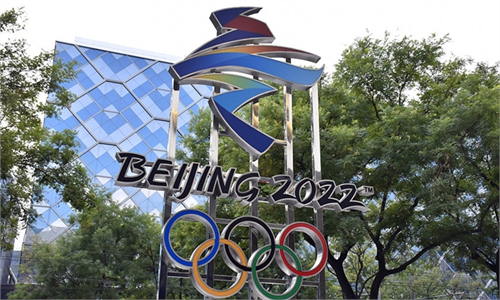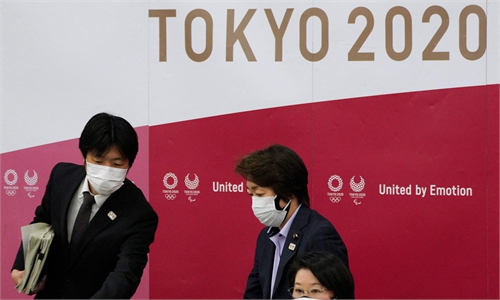
Ice hockey players practise during a test event for the 2022 Beijing Winter Olympic Games at the National Indoor Stadium in Beijing on Thursday. The test event series will run until April 10. Photo: AFP
Technological advances will become a key part of the Beijing 2022 Winter Olympic Games, as smart robots, 5G-enhanced "bullet-time" camera arrays and cloud-based broadcasting are tested in a major venue for the games.
These developments offer a glimpse into what might be the most technology-driven sports event ever, observers said.
The Winter Olympics is likely to be the first major international sports event where 5G technology would be applied on a large scale, an industry veteran said.
Smart robots, featuring a laser-and-vision-enabled automatic collision avoidance and navigation system, are being used to send documents, office supplies, hockey equipment and other items from one place to another in the Wukesong Arena, the Beijing News reported on Sunday.
The arena is one of the 2008 Summer Games sites that were redesigned for the coming Winter Games.
The main stadium for the Winter Games testing in the arena and the training stadium are about 150-200 meters apart, and hockey players' equipment is fairly heavy, making transportation a challenge.
The smart person-following robots, however, can help in moving the equipment.
In addition, the Wukesong Arena has adopted bullet-time technology, referring to a visual effect to slow down or freeze time amid high-speed movements, through an array of dozens of cameras that are capable of multi-directional shooting in 120-150 degrees. These images will then be pre-processed through 5G multimedia devices before transmission.
The 5G network is being used to stream videos to the cloud for image processing, and the videos will then be sent back to the shooting location, according to the Sunday report.
Members of the audience can watch the captured moments live via on-the-scene TVs or computers. Further, QR codes will be provided for the audience to interact and enjoy seeing the games at zero distance.
Interestingly, a set of video cameras will be deployed around the competition venue in the Wukesong Arena that would simultaneously shoot videos from different angles and allow for the audience to choose the best angle to appreciate the games, per the report, speaking of the "free visual angle" technology co-developed by the Institute of Automation of the Chinese Academy of Sciences.
The cloud-based broadcasting also innovates the traditional broadcasting model, with multi-channel, ultra-high-definition video signals transmitted to the cloud through 5G or fixed telecom networks.
These will be processed on the cloud before being transmitted to TV stations or internet video platforms. In so doing, program producers don't need to be on the scene, tremendously reducing the number of people involved and boding well for the containment of COVID-19.
The Winter Games will also feature remote interviews and press conferences as the virus containment efforts continue.
All these applications - on the back of China's ramped-up push for 5G networks and moves to tailor applications for the Winter Olympics - pave the way for the 2022 event to be the first major international sports event to apply 5G technology on a large scale. These are feats that the 2021 Tokyo Olympics won't achieve, Fu Liang, an independent veteran telecom industry observer in Beijing, told the Global Times on Monday.
Global Times



